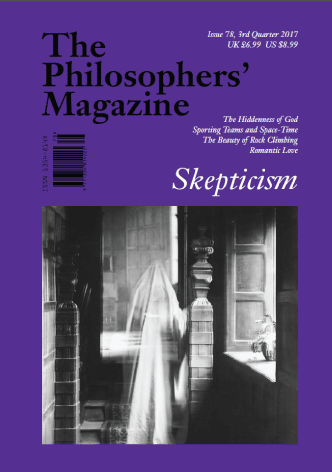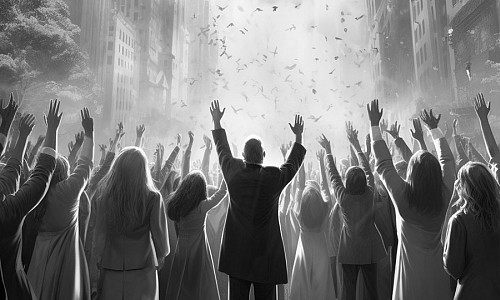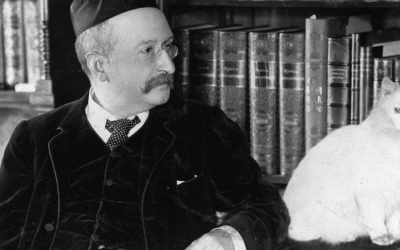Massimo Pigliucci on the metaphysical implications of an approach to physics that suggests time and space are not entities, but rather ways to order events.
I have devoted a serious amount of time to reading the new book by Roberto Mangabeira Unger and Lee Smolin, The Singular Universe and the Reality of Time: A Proposal In Natural Philosophy [1]. Indeed, this review actually pertains to the first part of the book, written by Unger, the philosopher in the pair. Eventually I will come back to it with a second review, focusing on the part written by Smolin, the physicist. They make the same argument, but one goes at it from a broad, philosophical perspective, the other from a more empirical, scientific point of view.
It is an ambitious book, bound to be controversial both among philosophers and among scientists, but it is worth the effort, if nothing else in order to expose one’s mind to a fairly radical way of conceiving of metaphysics, physics, and mathematics — and this despite the fact that the first part, written by Unger, is somewhat slow going and repetitious, compared to Smolin’s contribution.
Before we get to what the authors set out to accomplish, it is worth discussing a more basic premise of the book: they see it as an exercise in what they call (a revived form of) “natural philosophy.” Of course, natural philosophy was the name by which science went before it became a field of inquiry independent of philosophy itself. Descartes, Galileo, Newton and even Darwin thought of themselves as natural philosophers (the word scientist, in fact, was invented by Darwin’s mentor, William Whewell, in 1833 [2]). But what’s the point of going back to the old term, aside from a bit of historical nostalgia and perhaps intellectual pretentiousness?
Actually, Unger & Smolin (henceforth, U&S) make a very good case for it, which begins with the observation that many of their colleagues have indeed engaged, often stealthily, or perhaps without recognizing it, in precisely this sort of activity. You may have noticed over the last several years the appearance of a number of books written by scientists and allegedly aimed at the general public, but upon closer inspection turn out to be a bit like those recent delightful Disney and Pixar movies: two-track productions, with the obvious and most accessible one aimed at young audiences, interwoven with more sophisticated jokes that only the cognoscenti (i.e., the adults, as far as the movies are concerned) understand and enjoy. These exercises in natural philosophy, according to U&S, have been written by scientists who want to talk not just to a lay audience, but also to their colleagues, outside of the strict and constraining formalism of peer review. Think of such books as long op-ed pieces that scientists (partly) aim at each other in order to influence the agendas of their respective fields.
This strikes me as exactly right, and makes new sense of a number of books I have read (and perhaps of some I have written?) over the years. For instance, I can count as exemplars of this new genre: Peter Woit’s Not Even Wrong (on string theory [3]); The Mating Mind, by Geoffrey Miller (on human sexual selection [4]); Capital in the Twenty-First Century, by Thomas Piketty (on economics [5]); Guns, Germs, and Steel, by Jared Diamond (on social evolution [6]); The Plausibility of Life, by Marc Kirschner and John Gerhart (on the evolution of evolutionary theory [7]), among many, many others. Indeed, arguably the approach goes all the way back to Darwin’s own Origin of Species, which had the distinction of being written for other naturalists, and yet selling out with the general public within the first day of distribution.
Unger describes the phenomenon in this way:
“Today, natural philosophy has not disappeared completely. It lives under disguise. Scientists write popular books, for the general educated public, professing to make their ideas about the science that they practice accessible to non-scientists. They use these books to speculate about the larger meaning of their discoveries for our understanding of the universe and of our place within it. They also have another audience, however: their colleagues in science, addressed under the disguise of popularization.” (p. 82)
Let us be clear that U&S (as well as myself) do not for a moment think that the scientists in question are doing anything unsavory, or engaging in a duplicitous advertising campaign. On the contrary, what the authors wish to do is to make the trend clear and take advantage of it to push their own agenda about physics and cosmology. I find the whole idea quite refreshing, regardless of whether one ends up agreeing or not with U&S’s specific proposals.
Unger identifies four signs of natural philosophy (pp. 75-77):
“Its first hallmark is to take nature as its topic: not science, but the world itself. It engages in controversy about the direction and practice of part of science only as part of a larger argument about nature. The proximate subject matter of the philosophy of science, as now understood and practiced, is science. The proximate subject matter of natural philosophy is, and has always been, nature. … A second characteristic of natural philosophy is to question the present agenda or the established methods in particular sciences. It does so from a distance rather than from within science. …A third trait of natural philosophy, as we exemplify it here, represents a break with much of the way in which natural philosophers used to view their own work when natural philosophy was an accepted genre. We deal with problems that are both basic and general. We do so, however, without depending on metaphysical ideas outside or above science. … A fourth characteristic of natural philosophy, as we here interpret and try to recover it, is that, as it intervenes in discussion of the agenda of natural science, it attenuates the clarity of the divide between a discourse within science and a discourse about science.”
I think Unger is being a bit optimistic about the possibility of not “depending on metaphysical ideas outside or above science,” but in other parts of his contribution to the book he seems to be arguing for a more modest (and eminently achievable) aim: to highlight a science’s (inevitable?) metaphysical commitments and to reduce them to the bare and justifiable minimum.
I do like the distinction being drawn here between natural philosophy and philosophy of science, based on the idea that there are three possible “discourses” to be carried forth: within science (properly done by scientists); outside of science (properly done by philosophers, of science); and simultaneously within and outside (to which both philosophically inclined scientists and scientifically inclined philosophers are welcome). I may have to change my office door label to “Natural Philosopher”…
All of the above taken as a preamble, what is it, exactly, that U&S are arguing for, and on what basis? Here I will draw heavily on the introduction to the book, common to both Unger’s and Smolin’s separate contributions, and I will intersperse my commentary as I see fit.
U&S present three fundamental ideas for the consideration of their readers:
“The first idea is the singular existence of the universe. … There is only one universe at a time, with the qualifications that we discuss. The most important thing about the natural world is that it is what it is and not something else. This idea contradicts the notion of a multiverse — of a plurality of simultaneously existing universes — which has sometimes been used to disguise certain explanatory failures of contemporary physics as explanatory successes.” (p.x)
All I have to say, pace my friend Sean Carroll and a number of other physicists and cosmologists: amen! U&S explain that there is no particular scientific reason to believe in the multiverse, that the idea is empirically untestable and therefore not scientific (yes, they are aware of claims to the contrary, and they deal with them), and that the whole concept is a metaphysical (in a bad sense of the word) cover up for what they see as the current failure of cosmological models.
“The second idea is the inclusive reality of time. Time is real. Indeed, it is the most real feature of the world, by which we mean that it is the aspect of nature of which we have most reason to say that it does not emerge from any other aspect. Time does not emerge from space, although space may emerge from time.” (p. x)
They explain that this conviction comes out of taking seriously what they consider (rightly, I think) cosmology’s most fundamental discovery of the 20th century: that the universe has an age. This discovery, they argue, is incompatible with the oft-repeated idea that time is relative and that there is no privileged absolute measure of it. Before you throw general relativity at me, consider that these two know what they are talking about. They are perfectly aware of Einstein’s theory, and they deal with it accordingly, philosophically in the first part of the book, scientifically in the second one. They do not reject GR, they simply reject what they think are unwarranted metaphysical extrapolations of it that physicists have taken for granted but that can be challenged in light of the empirical data coming out of cosmology.
“The third idea is the selective realism of mathematics. (We use realism here in the sense of relation to the one real natural world, in opposition to what is often described as mathematical Platonism: a belief in the real existence, apart from nature, of mathematical entities.) Now dominant conceptions of what the most basic natural science is and can become have been formed in the context of beliefs about mathematics and of its relation to both science and nature. The laws of nature, the discerning of which has been the supreme object of science, are supposed to be written in the language of mathematics.” (p. xii)
But they are not, because there are no “laws” and because mathematics is a human (very useful) invention, not a mysterious sixth sense capable of probing a deeper reality beyond the empirical. This needs some unpacking, of course. Let me start with mathematics, then move to the issue of natural laws.
I was myself, until recently, intrigued by mathematical Platonism [8]. It is a compelling idea, which makes sense of the “unreasonable effectiveness of mathematics” as Eugene Wigner famously put it [9]. It is a position shared by a good number of mathematicians and philosophers of mathematics. It is based on the strong gut feeling that mathematicians have that they don’t invent mathematical formalisms, they “discover” them, in a way analogous to what empirical scientists do with features of the outside world. It is also supported by an argument analogous to the defense of realism about scientific theories and advanced by Hilary Putnam: it would be nothing short of miraculous, it is suggested, if mathematics were the arbitrary creation of the human mind, and yet time and again it turns out to be spectacularly helpful to scientists [10].
But there are, of course, equally (more?) powerful counterarguments, which are in part discussed by Unger in the first part of the book. To begin with, the whole thing smells a bit too uncomfortably of mysticism: where, exactly, is this realm of mathematical objects? What is its ontological status? Moreover, and relatedly, how is it that human beings have somehow developed the uncanny ability to access such realm? We know how we can access, however imperfectly and indirectly, the physical world: we evolved a battery of sensorial capabilities to navigate that world in order to survive and reproduce, and science has been a continuous quest for expanding the power of our senses by way of more and more sophisticated instrumentation, to gain access to more and more (and increasingly less relevant to our biological fitness!) aspects of the world.
Indeed, it is precisely this analogy with science that powerfully hints to an alternative, naturalistic interpretation of the (un)reasonable effectiveness of mathematics. Math too started out as a way to do useful things in the world, mostly to count (arithmetics) and to measure up the world and divide it into manageable chunks (geometry). Mathematicians then developed their own (conceptual, as opposed to empirical) tools to understand more and more sophisticated and less immediate aspects of the world, in the process eventually abstracting entirely from such a world in pursuit of internally generated questions (what we today call “pure” mathematics).
U&S do not by any means deny the power and effectiveness of mathematics. But they also remind us that precisely what makes it so useful and general — its abstraction from the particularities of the world, and specifically its inability to deal with temporal asymmetries (mathematical equations in fundamental physics are time-symmetric, and asymmetries have to be imported as externally imposed background conditions) — also makes it subordinate to empirical science when it comes to understanding the one real world.
Perhaps the best example of this tension is provided by the backward extension of the field equations of general relativity, which is the basis for the claim — rejected by Unger and Smolin — that the universe began with a “singularity” characterized by infinite mass and energy. They flip things around, asserting that the logical impossibility, as well as the complete dearth of empirical evidence, of any infinite quantities in nature must take precedence instead. If GR predicts physical infinities too bad for GR: it simply means that that particular theory, like all scientific theories, has a specific domain of application (admittedly, fairly large: most of the known universe for most of its history), beyond which it breaks down (more on this below). Some physicists, according to U&S, commit instead the same mistake as the (fictional) authors of the Hitchhiker’s Guide to the Galaxy, warning their readers that in case of conflict between the Guide and Reality, it is Reality that is at fault…
Interestingly, in other domains of physics it is the physicists themselves who gladly follow U&S’s advice. Take, for instance, the emergent phenomenon of phase transitions [11]. It turns out that the curves describing transitions between states of matter are the same regardless of the specifics of the substance, indicating a universal phenomenon underlying these processes. Moreover, by far the best (though, crucially, not the only) mathematical treatment of phase transitions invokes, you guessed it, singularities! That is, the mathematical physicist works things out as if the number of molecules involved in phase transitions was infinite, which allows him to deploy some very elegant and very treatable mathematical formalisms to describe the physics. But of course everyone knows that this is just an idealization: number of molecules is never an infinite quantity, only a very very large one. Why then, make a metaphysical 180 in the specific case of the Big Bang? I think Einstein himself would have appreciated a bit more deference to the empirical here.
And now to the issue of laws of nature. The whole idea has a controversial history [12], and is of surprisingly recent vintage. Among early natural philosophers, Descartes, and then Newton, were enthusiastic supporters of the notion, which of course they directly ascribed to the existence of a creator God: after all, if there are Laws, we need a Law-giver of some sort. Hobbes and Galileo, on the contrary, were distinctly unexcited by it, preferring instead to talk about empirical approximations and generalizations. While the Cartesian-Newtonian camp holds sway in modern physics, a number of philosophers before U&S have pointed out that this is likely a mistake, introducing an enigma (where do the laws come from?) in order to explain a mystery (some observed regularities in the way the universe works).
Two such philosophers are Nancy Cartwright and Ian Hacking. They independently published two seminal books on the topic back in 1983: How the Laws of Physics Lie (how’s that for a controversial title? [13]) and Representing and Intervening [14], respectively.
According to Cartwright in particular, laws of nature are not true generalized descriptions of the behavior of particles, say, but rather statements about how particles would behave according to idealized models. Her crucial point being that theories are to be re-interpreted as (empirical), idealized models of reality, not as more or less isomorphic (true) maps of the world.
Cartwright distinguishes between fundamental and phenomenological laws: fundamental laws are those postulated by realists, and they (supposedly) describe the true deep structure of the universe; phenomenological laws, conversely, can be used to make predictions, they work well enough, but they are strictly speaking, false.
Newtonian mechanics is then interpreted as a phenomenological law: it is an idealization that works well for certain practical purposes. Crucially, for Cartwright, all laws are like that (so she is an anti-realist about laws), which means that in physics, instead of looking for a fundamental “theory of everything” we should be working instead on putting together a coherent patchwork of local (phenomenological) theories and laws, each characterized by a limited domain of application.
Here is how she puts it: “neither quantum nor classical theories are sufficient on their own for providing accurate descriptions of the phenomena in their domain. Some situations require quantum descriptions, some classical and some a mix of both.” To say something along the lines of “yes, but in principle we could use quantum mechanics for everything” is, according to Cartwright, to go beyond the empirical and wade into shaky metaphysical ground. While Unger and Smolin don’t quite go that far, the spirit of their criticism is similar. Interestingly, however, they derive it from an analysis of physical laws that begins with another staple of philosophical discourse: causality [15].
The basic idea put forth by U&S is simple, profound, and eminently reasonable: we usually explain causal processes and interactions by invoking laws. But in fact, they argue, it is more plausible to think that it is the (appearance of) laws that emerge from causal interactions. That is, causal processes are primary, and when they happen with predictable regularity we call the resulting pattern a law. This, in turn, stems from their treatment of time as not emergent: if there is anything that defines causality it is temporal asymmetry, and in fact time itself can be defined in terms of causality:
“If time were not real, there could be no causal relations for the reason that there would be no before (the cause) and after (the effect). … Nothing would distinguish causal connections, which are time-bound, from logical or mathematical relations of implication, which stand outside time.” (p. 7) And also: “Within this view, time is intimately and internally connected with change. Change is causal. Time is change. In the spirit of these propositions, we should take inspiration, not discouragement, from Mach’s remark: ‘It is utterly beyond our power to measure the change of things by time. Quite the contrary, time is an abstraction at which we arrive by the changes of things.’” (p. 222)
But, wait, I’m sure you are about to say, isn’t it the case that we have lots of empirical evidence that time changes depending on local conditions, such as the speed at which we move, or gravitational effects? Unger (and Smolin, in the second half of the book) have obviously considered this: “No necessary, one-to-one relation exists between the Einsteinian-Riemannian ontology and the hard empirical content of general relativity. We can keep the empirical residue while dispensing with the ontology.” (p. 232) The practical solution here is to conceive of absolute time not in terms of standard units, such as seconds, oscillations of reference atoms, and the like. Time is, if I understand U&S correctly, simply the succession of causal connections between events. This succession can locally take place at a different pace, but this does not invalidate the universally true fact that certain things (like, most obviously, the Big Bang) happened before (meaning that they were causally antecedent to) others.
There are two crucial consequences of this way of looking at things: to begin with, that the laws of nature themselves can change over “time.” Indeed, they already have. U&S think that the universe has gone through at the least two phases, and possibly many more before those. One phase was the Big Bang and what happened immediately before and after. During this sequence of causal events (i.e., “time”) things were happening that did not abide to anything like the predictable regularity we see operating today, because the causal processes themselves were changing. The second phase is the one of the cooled down universe, which has gone on for billions of years now, and which can (to a good approximation, as Cartwright would say) be described as law-abiding, because the nature of the causal interactions that characterize it is either not changing or not changing appreciably. But this state of affairs may not last forever, and the universe may go through yet another period of upheaval, and so on and so forth, indefinitely.
The second crucial consequence is that physicists should take cosmology seriously as a fundamentally historical science, to be modeled after some of the “special” sciences like geology and biology, not in the increasingly singular way in which fundamental physics proceeds. Indeed, the idea that the very regularities governing the universe change with the causal conditions appears odd only in fundamental physics, because it has been so influenced by abstract (and necessarily time invariant!) mathematics. All other sciences have long recognized the emergence of new patterns of behavior (i.e., new regularities) triggered by changed causal conditions. For instance, major transitions in biological evolution (e.g., from unicellular to multicellular life) have made possible entirely new modes of evolutionary change (a concept known as “evolvability” [16]) that were simply not instantiated before. The appearance of sentient beings capable of reasoning has triggered novel types of causal interactions described by the social sciences (psychology, sociology, history, economics), again following patterns that were simply not accessible to the universe before a certain point. This yields an appealing picture of open possibilities, where the future is not fixed by the past, but depends on how causality will change and on what novel forms it will take.
At the cost of further prolonging this already sizable half review, as it were, let me point out also that Unger clearly frames the project of the book within the context of two broad philosophical traditions:
“the relational approach to nature and the priority of becoming over being. … The relational idea is that we should understand time and space as orderings of events or phenomena rather than as entities in themselves. … In the history of physics and of natural philosophy the two chief statements of the relational view have been those formulated by Gottfried Leibniz in the late seventeenth century and by Ernst Mach in the late nineteenth century. … A second philosophical inspiration of this book is less easy to associate with a single doctrine, a ready-made description, or a few names. It is the tradition of thought that affirms the primacy of becoming over being, of process over structure, and therefore as well of time over space. It insists on the impermanence of everything that exists.” (pp. xiii-xv) Well, in terms of names at the least, I may suggest Heraclitus and Fu Hsi (the author of the I Ching, the aptly named “book of changes”).
These are, of course, far from uncontroversial ideas, but they are eminently defensible philosophical frameworks: time and space are not entities, but ways to order events, and the universe is not organized according to timeless (ah!) laws, but any regularity that characterizes it emerges from the unfolding of things.
This is where things stand at the moment. Now give me a couple more months to get through Smolin’s part of the book…
Endnotes
[1] The Singular Universe and the Reality of Time: A Proposal in Natural Philosophy, by R.M. Unger and L. Smolin, Cambridge University Press, 2014.
[2] Scientist, Wiki entry.
[3] Not Even Wrong: The Failure of String Theory and the Search for Unity in Physical Law, by P. Woit, Basic Books, 2006.
[4] The Mating Mind: How Sexual Choice Shaped the Evolution of Human Nature, by G. Miller, Doubleday, 2000.
[5] Capital in the Twenty-First Century, by T. Piketty, Belknap Press, 2014.
[6] Guns, Germs, and Steel: The Fates of Human Societies, by J. Diamond, W. W. Norton & Company, 1999.
[7] The Plausibility of Life: Resolving Darwin’s Dilemma, by M.W. Kirschner and J.C. Gerhart, Yale University Press, 2005.
[8] On mathematical Platonism, by M. Pigliucci, Rationally Speaking, 14 September 2012. But then see: Mathematical Universe? I ain’t convinced, by M. Pigliucci, 11 December 2013.
[9] The Unreasonable Effectiveness of Mathematics in the Natural Sciences, by E. Wigner, Communications in Pure and Applied Mathematics, vol. 13, No. I (February 1960). Then again, see for instance this rebuttal by Steven French: The Reasonable Effectiveness of Mathematics: Partial Structures and the Application of Group Theory to Physics, Synthese 125:103-120, 2000.
[10] Platonism in the Philosophy of Mathematics, by Ø. Linnebo, Stanford Encyclopedia of Philosophy.
[11] Essays on emergence, by M. Pigliucci, part I, part III and part IV, Rationally Speaking, 11 October 2012, 22 October 2012, and 25 October 2012.
[12] Are there natural laws?, by M. Pigliucci, Rationally Speaking, 3 October 2013.
[13] How the Laws of Physics Lie, by N. Cartwright, Oxford University Press, 1983.
[14] Representing and Intervening: Introductory Topics in the Philosophy of Natural Science, by I. Hacking, Cambridge University Press, 1983.
[15] Causal Processes, by P. Dowe, Stanford Encyclopedia of Philosophy.
[16] Is evolvability evolvable?, by M. Pigliucci, Nature Reviews Genetics 9:75-82 (2008).
Massimo Pigliucci is the K. D. Irani Professor of Philosophy at the City College of New York. His background is in evolutionary biology and the philosophy os science, though he has recently developed a keen interest in Stoicism. His most recent book (co-edited with Maarten Boudry) is Philosophy of Pseudoscience: Reconsidering the Demarcation Problem. His other writings can be found at Plato's Footnote.
You might also like...















